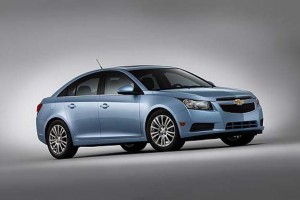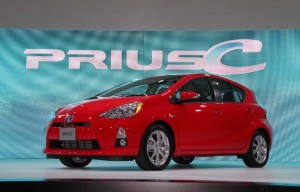Hoping to squeeze every last mile out of a gallon of gas? Automakers have been launching a flood of new “eco” models designed to do just that. But a new report warns that the minimal extra mileage isn’t worth the hefty price tag – which in some cases would require as much as 38 years of driving to recover in terms of lower fuel costs.
The new study by Consumer Reports raises questions about a variety of conventionally powered Eco models, such as Ford Focus SFE, Chevrolet Cruze Eco and Honda Civic HF. But it was also skeptical of the benefits promised by some hybrid models, such as the new Toyota Prius C which, it declares, “is fuel efficient, but not a deal.”
The problem is that the savings are offset by hefty initial premiums averaging between $500 and $800 above standard models. But in some cases, the savings on fuel may be as little as $20 per year. And, in some cases, consumers wind up sacrificing further in terms of cheaper interiors and poor road dynamics.

It would take 38 years for the savings on fuel to cover the added cost of the Chevy Cruze Eco model.
The Chevy Cruze Eco is a prime example, according to CR researchers. The special model undergoes some aerodynamic “tweaks,” and gets low rolling resistance tires – which add $800 to the price tag when compared to the similar Cruze LT. But even then, fuel economy increases just 1 mile per gallon, to a mid-pack 27 mpg in the City. Highway mileage jumps 4 mpg, to 40.
For the typical owner, that would yield just $20 a year in savings for the typical driver clocking 12,000 miles a year and paying $4 a gallon – and require a 38-year “payback” to recover the Cruze Eco’s added cost. Savings would be a little better, the non-profit publication added, for those who do a lot of highway driving.
The Honda Civic HF also tacks on another $800 to cover the low rolling resistance tires, rear spoiler and sealed underbody that reduces aerodynamic turbulence. That results in a 3 mpg jump in the compact model’s mileage, to a combined 33 mpg. But even then, annual mileage savings are a modest $135, meaning a 6-year payback period – which is longer than most Americans keep a new car.
And the magazine gave the overall driving dynamics of the Civic HF a poor review, which “places it near the bottom” of all small sedans.
The magazine was much more upbeat about the “solid feel” of the Ford Focus SFE – short for Super Fuel Economy – which gets flush hubcaps, a rear spoiler and those higher-mileage tires. The SFE package gets a 3 mpg bump, to 31 mpg Combined, which Consumer Reports estimates would save $145 annually. The package only costs $495, so payback is a shorter 3.5 years.
While CR has often praised Toyota’s original Prius hybrid model, the magazine’s report is far less kind to the new Prius C, the compact addition to the expanding Prius “family.” While the new model’s City mileage rating of 37 mpg is “stellar,” the trade-off is significant in terms of the overall look and feel of the vehicle.
At a list price of just $20,850, the magazine declared, “drivers will get what they pay for. This subcompact hatchback, which is related to the lackluster Toyota Yaris, suffers from a stiff ride, very noisy cabin, slow acceleration, and cheap-looking interior trim.”
Overall, the Prius C’s test score, said Consumer Reports, puts it slightly under its chief competitor, the mediocre Honda Insight, and is too low for us to recommend the model.”

